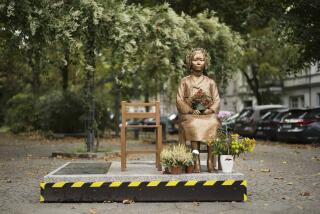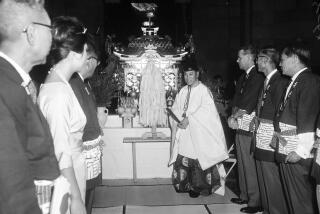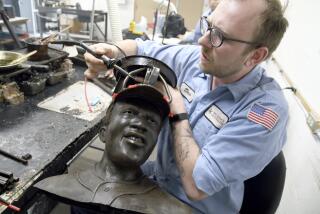A little piece of Liberty
- Share via
RIO DE JANEIRO — The Rio suburb known as Vila Kennedy would seem to have little in common with New York.
The rough district, far from the city’s glitzy beachfront, boasts no cinemas, no museums, no Central Park -- in fact, no park at all.
But Vila Kennedy does have a Statue of Liberty.
Right there, on a stone pedestal overlooking the main highway, amid trash, traffic and sundry shops, stands a 9-foot-high replica of the iconic monument at the entrance to New York Harbor. And it does indeed look down on Brazil’s tired, poor, huddled masses -- Vila Kennedy ranked 151st of 161 Rio communities on a United Nations development ranking.
The story of how the statue came to stand in one of Rio’s humblest communities rivals the epic tale of the 225-ton original -- given to the United States by France to commemorate 100 years of American independence (though it was a decade late, dedicated in 1886).
According to Brazilian historian Milton Teixeira, Vila Kennedy’s replica was commissioned in the early 1900s by Jose Maria da Silva Paranhos, an acclaimed Brazilian diplomat and historian. Why Paranhos, known as the Baron of Rio Branco, sought the statue remains unclear.
The baron passed it on to his cousin, a wealthy coffee merchant, and for years it resided in a home in the picturesque Rio neighborhood of Urca, Teixeira said. When the house was demolished in 1962, the statue went to Carlos Lacerda, then governor of Guanabara state and an admirer of President Kennedy, whose vision, charisma and Roman Catholic faith clicked with many Latin Americans.
At the time, authorities were clearing shantytowns known as favelas from downtown and moving residents to planned communities outside town. Some new developments, such as Vila Kennedy, were built with the help of U.S. funding from Kennedy’s Alliance for Progress, an initiative meant to counter communist influence in the region.
Someone in the government, with no apparent irony, decided that the ideal spot for the “Mother of Exiles” would be with the Rio inhabitants banished from their former homes.
Authorities placed the statute in a central site known as Miami Plaza. Its soaring grace amid the drab surroundings, along with JFK’s message of hope, stirred impoverished neighbors. Some even named their children after Kennedy and his family.
“My mom always spoke about him and what he did for the poor,” said Kenedy da Silva, 43, a government worker whose sister was christened Jacqueline.
Although Rio’s iron replica Lady Liberty is not believed to be the work of Frederic-Auguste Bartholdi, the French sculptor who created the original, it was probably made outside Paris from Bartholdi’s casts, Brazilian and U.S. experts said.
Scores of small copies were made in cast iron and bronze by the Societe Antoine Durenne and the Thiebaut Freres foundries, said Edward L. Kallop Jr., a former curator at the Statue of Liberty in New York and a researcher on replica statues for Christie’s auction house.
Many went to small towns in France and were later melted down by Nazi occupiers, Kallop said in a telephone interview from his home in Maine. But, he added, about 20 replicas, including a few sent overseas, still stand as valuable historical pieces, many with inscriptions commemorating important local dates.
The tablet in the left hand of Rio’s Lady reads not “July 4th, 1776,” but “15 de Novembro, 1889” -- the day Brazil declared itself a republic.
Today, her dignified figure towers over dilapidated stalls hawking used machine parts, wigs, coconut water, Bermuda shorts and string bikinis. Buses spewing thick exhaust disgorge passengers at the terminus in front of her. All around the stone plinth lie discarded pallets, plastic bottles and other detritus.
In a poignant irony for a sculpture whose New York big sister is officially named “Liberty Enlightening the World,” public lighting in the square is in chronic disrepair. Many fear vandalism or worse -- that audacious thieves could make off with her.
“If it’s not taken care of, it’ll be shot at, vandalized, pulled down or even disappear,” warned Mario del Rei, an activist and former councilman.
Rio officials are examining a proposal to give Lady Liberty protected status, while improving lighting and stiffening penalties for anyone caught damaging this symbol of freedom in Vila Kennedy and beyond.
Right now, protecting her is left largely to locals who keep an eye out for their symbolic guardian. Many appreciate her illustrious presence, even if they know little about her provenance.
“Hmm, it’s familiar,” Aline Moreira, a student, replied when asked about the statue. “I know there’s another one somewhere. New York, right?”
--
Times staff writer Patrick J. McDonnell in Buenos Aires contributed to this report.
More to Read
Sign up for Essential California
The most important California stories and recommendations in your inbox every morning.
You may occasionally receive promotional content from the Los Angeles Times.










